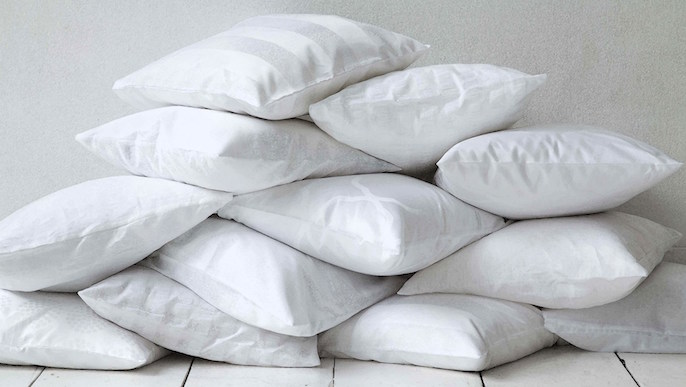A good quality pillow or duvet will last a long time. But how do you dispose of pillows and duvets once they have reached their end of life? Read on to find out how.
A good night’s sleep is vital for physical and mental health. A sure way to improve the quality of your sleep is by improving your mattress and bedding. You can maintain bedding for so long but their quality will decrease with time. If you feel your pillow doesn’t support your head well or the duvet feels like a sheet, it’s time to replace them.

How Often Should You Replace Your Pillows and Duvet?
Pillows and duvets can serve you for years before tapping out. They come in different fillings from natural to synthetic, feather, silk, or wool. The quality ranges from expensive to cheaper items you can pick from a convenience store near you. After using your duvet or pillow, what are the signs you need to replace the old ones?
How Long Do Pillows and Duvets Last?
Most people assume pillows should last as long as a mattress. However, that’s a wrong assumption. Similar to your bedding, pillows also collect body oil, hair, dust, and dead skin cells. Therefore, to create a fresh cleaning environment, you need to change your pillows regularly.
In the meantime, use a protective pillowcase to keep your pillow clean and clean the case every week. You can also wash the pillow after every three months to remove the collected dirt.
You should have a pillow for a year or two depending on the amount and type of pillow stuffing. Pillows with different stuffing serve you for a different period. Here are common types of pillow fillings and their lifespan.
Memory Foam Pillows
Memory foam pillows are made of blocks or shredded memory foam fillings. Such pillows support the neck well and conform to the weight of the head, neck, and shoulders. These pillows last between 3 to 4 years. Note that these pillows can’t be washed in washing machines or dryers. You can only hand wash or do spot cleaning with detergent and air dry.
Find the best memory foam pillow for you - Read our Best Memory Foam Pillow Buyers Guide
Latex Pillows
Latex pillows are made of synthetic latex or natural rubber tree sap. The pillows are supportive with a medium bouncy feel. They are dust mites resistant and great for people with allergies. These pillows last between 2 to 4 years. You can spot clean or hand wash every 2 to 3 months with warm water and detergents.
Find the Best Latex Pillows on the Market
Polyester or Synthetic Down Pillows
Polyester pillows are the most common and cheap pillows available on the market. They have a short lifespan of about 6 months to 2 years. The pillows can be machine washed easily with cold water and a detergent. You can also air dry or use a dryer. You can choose to replace these pillows as often as you’d want without hurting your budget.
Feather Pillows
Feather stuffing is soft and comfortable. They come from the bird’s belly and can last up to 1 to 3 years when well maintained. You can machine-wash them and air-dry them after every 3 to 6 months. Make sure you’re gentle when cleaning the pillows to improve their lifespan.
Find the Best Feather and Down Pillows - Our Buyers Guide
Duvets
As for duvets, you can have one for up to 5 to 7 years if you wish to. However, you don’t need to wait that long before replacing it. Duvets can last long since they don’t support weight like a pillow or mattress. All you need is its warmth all night long. To extend your duvet’s life span, you can buy a duvet cover and wash it with your sheets. You can clean the duvet at least once every month.
Signs You Need To Replace Your Pillows and Duvets

Permanent stains and discoloration
Over time, your pillows or duvets may lose their original color and start turning yellowish or brownish even after cleaning. You can try a few washes to see if the stains reduce. If not, it’s time to let go.
Odor
Your pillows or duvets should never have a bad odor stuck on them. Normally, your beddings pick up bad odors from sweat, mold, urine, or other things, but after washing them the bad odor disappears. However, if the bad odor persists, it’s time to dispose of them.
Worn out
When your pillows start feeling loose, flat, or uncomfortable even after fluffing, it’s run their course. You’ll start noticing neck pain frequently every morning or a series of headaches. Before you self-medicate with your painkillers, you should consider changing the pillow. As for the duvet, you’ll notice loose fibers, thinning, patch fibers or it feels lighter than usual. You might miss the signs until you use a different one to notice.
Tears or holes
Similar to stains, tears or holes make your pillows or duvets look shabby. You need to maintain a standard and torn beddings are unacceptable. You deserve to sleep in a clean and neat place. Some damages might be small and you can repair but if the tear is beyond mending, it’s time to dispose of that pillow.
Noticeable clumps
After a while, your duvet or pillow fillings start clumping together. This might be as a result of trapped moisture or the fillings are damaged. That way the duvet or pillows have lumps in some parts and empty in other parts. Since it’s impossible to separate the lumps especially in duvets, replace them immediately.
Lost warmth
When the fillings in your duvet feel weak, your duvet can’t keep you warm. When a duvet is new, the fillings trap in the air to maintain your body temperature. So if it loses its quality, you’ll notice temperature drops at night even when you’re fully covered.
Increased allergies
Pillows and duvets can host dust mites, dust, mold, and dead skin. Dust mites might cause breathing difficulties, an itchy throat, watery eyes, a runny nose, and nasal congestion. Dust and dead skin can also trigger breakouts and acne on your face and neck. Over time, these conditions might worsen or cause poor sleeping patterns.
Neck pain and headaches
When you sleep in a poor neck position, the next morning you’ll be feeling tired with a stiff neck and headaches. After prolonged use, your pillow quality may decrease making your head position unnatural. Replace the pillow as soon as you feel these symptoms to avoid walking around tired all the time.

How to Recycle Duvets and Pillows
You might feel attached to your pillows or duvets after prolonged use. It is normal since they’ve served you for a long time. You have to let go of the old bedding to create space for new ones. In addition, you get to choose a pillow that supports your head better and a duvet that keeps you warm even during winter.
Before you decide on your disposal method, you need to check the duvet or pillow’s content. Some materials such as feathers can be recycled or reused while the synthetic ones can’t be repurposed. If the pillow or duvet can be recycled, there are a few places that the beddings can be placed into good use.
Donate Your Old Pillows and Duvets
If your beddings still have some life in them, you can donate to several organizations that would appreciate the extra beddings. First, check if there are any large holes or nasty stains on them. Clean them thoroughly, dry, and fold them neatly before giving them out to:
Homeless Shelters: Many homeless shelters have a short supply of warm beds and are always open to receiving donations. During the Winter seasons, the shelters are usually overcrowded and they can’t afford to buy more. Most of the donations go to maintain keeping the doors open and buying food, making the beddings a luxury they can’t afford. You can pack them nicely and drop them at the nearest shelters near you.
Homeless people: while shelters try to keep the homeless people off the streets, there’s hardly enough space to cover them all. Sadly, the number of homeless people continues to rise every day. So you can donate directly to those poor people to help them keep warm during the long cold nights.
Charities: Local charities such as Goodwill, American Red Cross, and Salvation Army also accept bedding donations. They only accept beddings that are still in good condition and pass on to the less fortunate families. The charities might have limited space so you need to call ahead to confirm if they’re taking donations. Keep in mind, due to Covid-19 strict measures, some charities are turning down donations, and it’s not personal. So it’s important to find out the process before showing up with your large duvet or pillows and risk being turned down.
Churches: Churches also run programs to help the poor, needy, and homeless people in society. You don’t have to be a member of the church to donate your duvet and pillows. Get in touch with the church leaders and confirm if they’re receiving donations, drop-off requirements, or free pick-up services. You can also search online for other faith-based charities within your vicinity.
Animal Shelters: Animal shelters may also need beddings. These places may not be your first choice but the rescue animals need warmth too. The pillows and duvets keep the cages comfortable and warm for the cats and dogs before they find new homes. You can also take to pet charity shops to sell the beddings as second-hand goods to help other pets. Don’t forget to call in first before delivering the beddings to their doorstep.
Conclusion
Whilst you may be done with your old pillow or duvet, think twice about throwing them in the rubbish. If you consider how to dispose of your pillows and duvets properly, another person in need could be very thankful for your choice.
